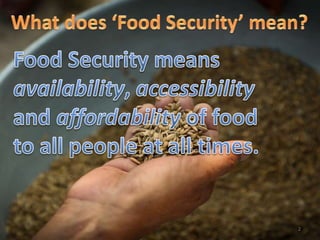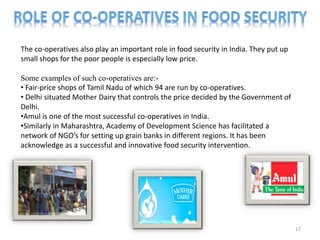Food security
- 1. 1
- 2. 2
- 3. Availability of food means food production within the country, food imports and the previous years stock stored in government granaries. Accessibility means food is within reach of every person. Affordability implies that an individual has enough money to buy sufficient, safe and nutritious food to meet one’s dietary needs. 3
- 4. (famine -- widespread deaths due to starvation and epidemics caused by forced use of contaminated water or decaying food and loss of body resistance due to weakening from starvation.) 4
- 5. Famine takes place Decrease in total production of food grains Shortage of food in the affected areas Rise in food price Some people cannot to buy food FOOD INSECURITY 5
- 6. 6
- 7. HIGHEST GROWTH Punjab And Haryana Tamil Nadu and Andhra Pradesh LOWEST GROWTH Maharashtra and Madhya Pradesh Bihar Orissa and the NE states. 7
- 9. Hungeris anotheraspectindicatingfoodinsecurity.Hungerisnot justanexpressionof poverty,it brings aboutpoverty.Theattainmentof foodinsecuritythereforeinvolveseliminatingcurrenthungerandreducing theriskof futurehunger. Chronic hunger is a consequence of diets persistently inadequate in terms of quantity and/or quality. Poor people suffer chronic hunger due to low income in turn inability to buy food even for survival. Seasonal hunger is related to cycles of food growing and harvesting. This is prevalent in rural areas due to seasonal nature of agricultural activities and in urban areas because of the lack of casual labour e.g., lack of casual construction labour during the rainy seasons. 9
- 10. Bengal Famine of 1943 caused death of around 1.5-3 million people. The Bihar Famine of 1966-67 killed 2353 people due to starvation as reported. Places like Kalahandi and Kashipur,Orissa famine and starvation deaths have been reported. Starvation deaths have been also reported in Baran district of Rajasthan, Palamau district in Jharkhand and many remote areas during the recent years. 10
- 11. 11
- 12. 12
- 13. Rationing is the controlled distribution of scarce resources, goods, or services, or an artificial restriction of demand. It controls the size of the ration, which is one's allowed portion of the resources being distributed on a particular day or at a particular time. it is often done to keep price below the equilibrium (market-clearing) price determined by the process of supply and demand in an unfettered market. Thus, rationing can be complementary to price controls. Rationing was introduced in India in the backdrop of the Bengal famine. This system was again revived in the 1960s to tackle acute shortage of food. In the 1970s, three important food intervention programmes were introduced to tackle the shortage of food: 1. Public Distribution System (PDS) : This system was made to ensure smooth supply of subsidized food items to the poor. 2. Integrated Child Development Services (ICDS) : These services were introduced to provide proper nutrition to poor children. 3. Food for Work (FFW) : This programme was introduced to help the poor to earn food in lieu of some work. Similarly, many Poverty Alleviation Programmes (PAPs) have been introduced from time to time to tackle the food shortage. Mid Day Meal scheme was launched in government schools to provide freshly cooked lunch to poor children. 13
- 14. The PDS is the most important step towards securing food in India. In 1997, the targeted Public Distribution System was introduced to extend the PDS benefits to the poor in all areas of the country. In the year 2000, two special schemes called the Antyodaya Anna Yojana and the Annapurna Scheme were introduced through the public distributions system. The Antyodaya Anna Yojana was aimed at the poorest of the poor and The Annapurna Scheme was aimed at needy senior citizens. 14
- 15. Name of the schemes Year of Induction Coverage target group Latest volume Issue price(Rs. Per kg.) PDS (Public Distribution System ) Up to 1992 Universal ----- W-2.34 R-2.89 RPDS (Revamped Public Distribution System) 1992 Backward blocks 20kg of food grains W-2.80 R-3.77 TPDS (Targeted Public Distribution System ) 1997 Poor and non-poor 35kg of food grains BPL-W-2.50 R-3.50 APL-W-4.50 R-7.00 AAY (Antyodaya Anna Yojana) 2000 Poorest of the poor 35kg of food grains W-2.00 R-3.00 APS (Annapurna Scheme) 2000 Indigent senior citizens 10kg of food grains FREE W- Wheat ; R- Rice; BPL-Below Poverty Line; APL-Above Poverty Line 15
- 16. Uttar Pradesh(eastern and south-eastern part), Bihar Jharkhand Orissa West Bengal Chhattisgarh Parts of Madhya Pradesh Maharashtra Rajasthan 16
- 17. The co-operatives also play an important role in food security in India. They put up small shops for the poor people is especially low price. Some examples of such co-operatives are:- • Fair-price shops of Tamil Nadu of which 94 are run by co-operatives. • Delhi situated Mother Dairy that controls the price decided by the Government of Delhi. •Amul is one of the most successful co-operatives in India. •Similarly in Maharashtra, Academy of Development Science has facilitated a network of NGO’s for setting up grain banks in different regions. It has been acknowledge as a successful and innovative food security intervention. 17
- 18. 18
- 19. 19


















